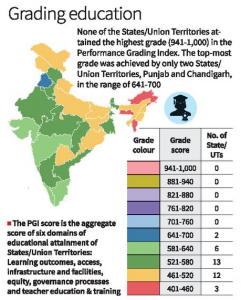July 13, 2023
Performance Grading Index: Catalyzing Transformation in School Education

Source: The Hindu
Introduction:
- The Union government recently released the annual Performance Grading Index (PGI) for the year 2021-22, which evaluates the performance of States and Union Territories in school education. While Chandigarh and Punjab emerged as top performers, there is still significant room for improvement across the board, as no state or UT achieved the highest grade, Daksh. The Performance Grading Index (PGI) serves as a tool to provide insights into the status of school education, identifying areas of strength and critical areas that require attention.
Assessing Key Parameters:
- The PGI evaluates various parameters to assess the performance of states and UTs in school education. These parameters include:
- Learning Outcomes: The PGI assesses students’ performance in subjects such as language, math, science, and social science, reflecting the effectiveness of teaching and learning methods.
- Access to Education: This parameter evaluates factors like net enrolment ratio, retention rates, transitions between educational levels, and the mainstreaming of out-of-school children. It focuses on ensuring equal opportunities for all children to receive quality education.
- Infrastructure: The availability of essential infrastructure such as science labs, computer labs, book banks, vocational education subjects, mid-day meal supply, functional drinking water facilities, and provision of uniforms and free textbooks is examined to ensure conducive learning environments.
- Equity: The PGI considers the performance gap between marginalized communities and the general category, along with the presence of inclusive infrastructure like ramps and disabled-friendly toilets, promoting equal access to education.
- Educational Governance and Management: This parameter assesses digital attendance records, the presence of single-teacher primary schools, vacancies in educational posts, inspections, and teacher evaluations. It emphasizes effective governance and management practices in the education system.
PGI Grades and Rankings:
- The PGI categorizes states and UTs into different grades based on their performance:
- Daksh: The highest grade, awarded to states scoring above 940 out of 1,000 points, signifies exemplary performance and comprehensive development of the education system.
- Akanshi-3: The lowest grade, awarded to states with scores up to 460 points, indicates a need for significant improvement in various aspects of school education.
- Top Performers: Chandigarh and Punjab secured the sixth-highest grade, Prachesta-2, showcasing commendable performance. Gujarat, Kerala, Maharashtra, Delhi, Puducherry, and Tamil Nadu closely followed at Prachesta-3.
- Improvement Needed: Thirteen states, including Andhra Pradesh, Chhattisgarh, Haryana, West Bengal, and Madhya Pradesh, were categorized as Akanshi-1 states, emphasizing the need for substantial improvement in their education systems.
Action for Improvement:
- The PGI report offers recommendations and suggests specific actions that states can undertake in each domain to enhance their overall scores. By focusing on these areas, states can drive transformational change in their school education systems:
- Strengthening Learning Outcomes: Implement innovative teaching methods, provide additional support to struggling students, and enhance teacher training programs to improve learning outcomes.
- Enhancing Access to Education: Implement initiatives to increase enrollment rates, reduce dropouts, and ensure smooth transitions between educational levels. Target efforts towards mainstreaming out-of-school children.
- Developing Infrastructure: Prioritize the development of science labs, computer labs, and other essential facilities. Ensure the availability of resources like textbooks, uniforms, and mid-day meals for students.
- Promoting Equity: Bridge the performance gap between marginalized communities and the general category through targeted interventions. Improve inclusive infrastructure to accommodate students with disabilities.
- Strengthening Governance and Management: Improve administrative practices, maintain accurate attendance records, address vacancies in educational posts, and conduct regular inspections and teacher evaluations to ensure accountability and efficiency.
The Conclusion:
- The Performance Grading Index (PGI) serves as a valuable tool to assess the performance of states and UTs in school education.
- By focusing on the key parameters and taking specific actions in each domain, states can work towards improving their overall scores, driving transformational change, and ensuring quality education for all students.
- The PGI report provides a roadmap for states to enhance their education systems and foster inclusive and effective learning environments.
Daily Gist : The Hindu/Indian Express : 30 Jan 2025
January 30, 2025
Gist of editorial : the Hindu/ Indian Express/20 Jan 2025
January 20, 2025
Daily the Hindu/ Indian Express Editorial Gist: 14 Jan 2025
January 14, 2025
